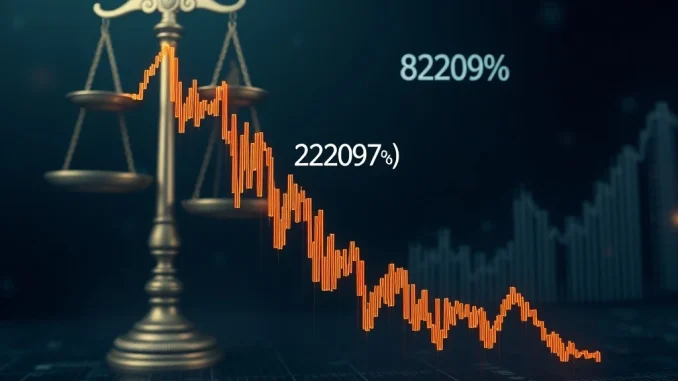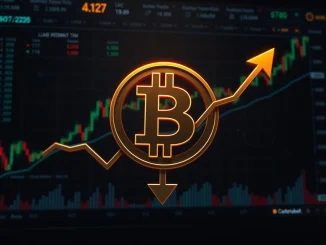
The cryptocurrency market is no stranger to volatility, but the recent performance of the MOVE token has sent shockwaves through the community. Imagine waking up to find a digital asset you hold has plummeted by an astonishing 8207.03% in just one year. This isn’t a hypothetical scenario; it’s the stark reality facing MOVE token holders, sparking urgent questions about the underlying causes of such a dramatic crypto decline. Our CryptoPulse Alert brings you real-time analysis on this unexpected price movement, aiming to keep traders ahead of the curve.
For many in the digital asset space, the promise of decentralized finance and community-driven projects represents the future. Yet, the story of the MOVE token serves as a potent reminder that even promising ventures can face immense challenges, particularly when fundamental pillars like governance and market liquidity falter. Let’s dive deep into the factors that have contributed to this precipitous drop and what it means for the future of the project.
Unraveling the Catastrophic MOVE Token Decline: What Went Wrong?
The numbers speak for themselves. A staggering 8207.03% loss in value over the past year is not merely a correction; it’s a catastrophic collapse that demands immediate attention. This long-term trend is further exacerbated by its short-term performance, with the token experiencing a 911.76% drop in just the last 30 days. Such figures paint a grim picture for investors and cast a long shadow over the project’s viability. But what exactly triggered this severe crypto decline?
Analysts and stakeholders point to a confluence of factors, primarily centered around internal structural shifts and external market pressures. The initial appeal of the MOVE project was its innovative approach and perceived community focus. However, as often happens in nascent industries, the path to stability can be fraught with unforeseen obstacles. The dramatic downturn suggests systemic issues rather than mere market fluctuations.
| Metric | Value | Implication |
|---|---|---|
| 1-Year Price Change | -8207.03% | Catastrophic long-term value erosion. |
| 30-Day Price Change | -911.76% | Accelerated short-term sell-off and loss of confidence. |
| Primary Concerns | Governance & Liquidity | Fundamental issues impacting trust and market functionality. |
The Troubled Core: Scrutinizing Crypto Governance Shifts
At the heart of the MOVE token‘s woes lies a contentious debate surrounding its governance model. Originally touted as a community-driven initiative, the project has reportedly transitioned towards a more centralized structure. This pivot, while defended by project leaders as a necessary step for streamlining operations and accelerating development, has ignited a firestorm within the community.
Why is this a problem? The core ethos of many blockchain projects, especially those aiming for decentralization, is to distribute power and decision-making among token holders. When this power is consolidated among a select group, it raises immediate concerns about:
- Transparency: Are decisions being made in the best interest of all stakeholders, or just a few?
- Accountability: Who is truly responsible when things go wrong, and how can the community hold them to account?
- Long-term Sustainability: Can a project truly thrive and adapt if its foundational principles are perceived to be compromised?
Critics argue that this centralization undermines the very decentralized spirit that attracted users to the platform in the first place. The shift in crypto governance has led to a significant erosion of trust, a vital component for any digital asset’s success. Without community buy-in and confidence in decision-making processes, even the most innovative technology struggles to gain traction and maintain value.
Where Did the Water Go? Addressing Liquidity Concerns
Beyond governance, the MOVE token faces severe liquidity concerns, which have compounded its downward spiral. In the cryptocurrency world, liquidity refers to how easily an asset can be converted into cash without affecting its market price. High liquidity indicates a healthy, active market where buyers and sellers can easily find each other. Low liquidity, conversely, means trading can be difficult, leading to greater price volatility and often, significant price drops.
Reports indicate that multiple liquidity pools for the MOVE token have seen drastically reduced activity, with some experiencing significant outflows. This means fewer buyers are willing to step in, and existing holders are cashing out, creating a vacuum that drives prices down further. While the project has attempted to incentivize liquidity provision through token rewards, these measures have yet to yield measurable improvements in market confidence or stabilize the price. The effectiveness of these strategies is directly questioned by the token’s continued freefall.
A lack of robust liquidity can create a vicious cycle: as prices fall, more investors panic and withdraw their assets, further depleting liquidity and accelerating the price drop. For the MOVE token, restoring robust liquidity is not just about incentivizing participation; it’s about rebuilding fundamental market trust.
Beyond the Hype: Re-evaluating Token Economics for Stability
The intertwined issues of governance and liquidity inevitably lead to a critical examination of the project’s token economics. Tokenomics refers to the economic principles that govern a cryptocurrency, including its supply, distribution, utility, and incentive mechanisms. A well-designed tokenomic model is crucial for a project’s long-term health and sustainability.
For the MOVE token, industry observers suggest that the current tokenomic strategy may be contributing to the instability. Key questions arise:
- Supply Management: Is there a clear, transparent plan for how new tokens are introduced into circulation, or are they being released in a way that creates excessive selling pressure?
- Reward Distribution: Are the incentives for participation (like liquidity provision) truly aligned with long-term value creation, or are they merely temporary fixes that dilute value?
- Utility and Demand: Does the token have sufficient real-world utility or demand drivers to counteract selling pressure from investors?
A more balanced approach to token economics, including a clearer roadmap for supply management and a revised reward distribution model, may be necessary to restore trust and attract new capital. Without a sustainable economic framework, even a project with a strong vision can struggle to maintain its value in the highly competitive crypto landscape.
Navigating the Storm: Community Response and Future Outlook for the MOVE Token
The broader ecosystem surrounding the MOVE token has responded with a mix of deep concern and cautious optimism. On one hand, the dramatic crypto decline has understandably led to frustration and calls for significant change. Several prominent community members have openly advocated for a reevaluation of the governance model, pushing for a return to more inclusive and decentralized decision-making structures. This reflects a strong desire among many for the project to realign with core blockchain principles.
On the other hand, some supporters emphasize the need for short-term stability over ideological considerations, expressing hope that the current leadership can navigate these turbulent waters. Despite the severe challenges, the project has maintained a relatively active development team. Ongoing work on infrastructure upgrades and cross-chain compatibility suggests that the underlying technical foundation is still being built upon. These efforts, if successful, could serve as a foundation for future growth and a potential rebound, offering a glimmer of hope amidst the crisis.
However, the path to recovery remains highly uncertain. Analysts project that the MOVE token‘s future performance will depend heavily on the project’s ability to decisively address its core issues. A successful overhaul of crypto governance, combined with a significant improvement in liquidity concerns and a revised approach to token economics, could serve as powerful catalysts for a potential rebound. Without clear and decisive action on these fronts, the current trajectory suggests further downward pressure in the near term, making it a critical period for the MOVE project and its community.
Lessons Learned from the MOVE Token’s Ordeal
The saga of the MOVE token offers several crucial takeaways for both project developers and investors in the volatile cryptocurrency market:
- The Primacy of Governance: Centralization, even if intended for efficiency, can severely erode community trust if not handled with extreme transparency and clear justification. Decentralized projects must uphold their foundational principles.
- Liquidity as a Health Indicator: Low liquidity is a red flag. It indicates a lack of market depth and investor confidence, making a token highly susceptible to price crashes. Projects must prioritize sustainable liquidity solutions.
- Sustainable Tokenomics is Non-Negotiable: A well-thought-out economic model that balances supply, demand, and incentives is vital. Projects must have a clear roadmap for token distribution and utility that supports long-term value.
- Community Engagement is Key: A project’s strength often lies in its community. Ignoring or alienating key stakeholders can lead to rapid decline, even if development continues.
- Due Diligence for Investors: This case underscores the importance of thoroughly researching a project’s governance structure, liquidity, and tokenomics before investing. Don’t just look at the technology; look at the economics and the people behind it.
Conclusion: A Critical Juncture for MOVE
The dramatic crypto decline of the MOVE token is a stark reminder of the inherent risks and complexities within the cryptocurrency market. While the project’s development team continues its work, the overshadowing issues of governance instability and severe liquidity concerns present formidable hurdles. The path forward demands not just technical innovation, but a fundamental re-evaluation of its operational philosophy and token economics.
For the MOVE project to reverse its fortunes, it must prioritize regaining community trust through transparent and inclusive crypto governance, implement robust strategies to address its liquidity concerns, and establish a sustainable tokenomic model. The future of the MOVE token hangs in the balance, a powerful case study in the challenges faced by digital assets attempting to navigate the volatile seas of decentralization and market dynamics.
Frequently Asked Questions (FAQs)
Q1: What is the MOVE token and what was its original purpose?
A1: The MOVE token is a cryptocurrency associated with a blockchain project. While the specific details of its original purpose aren’t fully outlined in the provided text, it was initially presented as a community-driven model, suggesting a focus on decentralized applications or services where community participation was key.
Q2: Why has the MOVE token experienced such a dramatic decline in value?
A2: The MOVE token’s significant decline (over 8200% in one year) is primarily attributed to two major factors: governance instability, specifically a shift from a community-driven model to a more centralized structure, and severe liquidity concerns, with reduced activity and outflows from its liquidity pools.
Q3: What are the main concerns regarding the MOVE token’s governance?
A3: The main concerns revolve around a recent governance update that centralized decision-making authority among a select group of token holders. Critics argue this undermines the project’s decentralized ethos, raising questions about transparency, accountability, and long-term sustainability for the crypto governance model.
Q4: How do liquidity concerns affect a cryptocurrency token like MOVE?
A4: Liquidity concerns mean there isn’t enough buying and selling activity in the market to allow for easy trading without significant price impact. For the MOVE token, reduced liquidity has led to difficulties in trading, increased volatility, and accelerated price drops as investors face challenges selling their holdings.
Q5: What role does token economics play in a project’s success or failure?
A5: Token economics (tokenomics) refers to the economic principles governing a cryptocurrency’s supply, distribution, utility, and incentive mechanisms. A poorly designed or managed tokenomics model can lead to inflation, lack of demand, and unsustainable rewards, directly contributing to a token’s price decline and undermining investor trust, as seen with the MOVE token.
Q6: What should investors consider before investing in projects facing similar challenges as MOVE?
A6: Investors should conduct thorough due diligence, focusing on the project’s governance structure (is it truly decentralized?), liquidity (are there active and healthy trading pairs?), and token economics (is the supply managed sustainably, and does the token have real utility?). Understanding these factors can help assess the long-term viability and risks of a crypto project.



